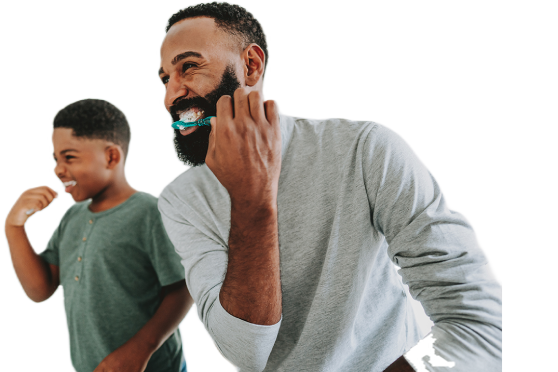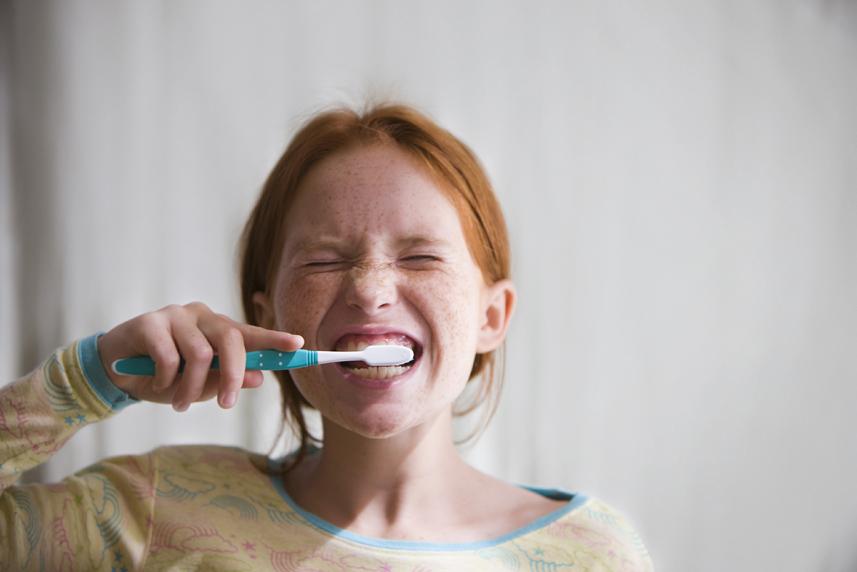
Your Premier Access plan makes it easy. No travel. No scheduling hassles. No additional cost to you! Click below to find your school and sign up.*
*You’ll be directed to MySchoolDentist to complete a permission form.
Breaking bad habits is hard work. But it’s worth the effort. Help get your child on the path to good dental hygiene with this expert advice.

Good dental care is a big part of your child’s health. When you help your child form good habits at an early age, you set them up for a lifetime of healthy smiles.
From thumb-sucking to skipping brushing, many habits can harm your kids’ teeth. Here are some reasons why, as well as expert tips to help you turn things around.
Kids and adults should always brush twice a day and floss once a day. This prevents plaque from building up on your teeth and gums. Plaque contains bacteria and germs.
When you eat, the bacteria in plaque uses the sugar in your food to make acid. If you don’t brush and floss regularly, that acid can chip away at the surface of the teeth. This can lead to cavities, tooth decay, and gum disease.
How you can help: A simple way to get kids to brush and floss is with rewards. Try a calendar system. Place a star on each day your child follows through with their routine. Give them a prize once they accumulate enough stars, suggests Mary J. Hayes, D.D.S., a pediatric dentist in Chicago and a spokesperson for the American Dental Association (ADA).
You might reward them with a new book. Or take them out for ice cream at the end of the month. (Be sure to brush after the ice cream!)
Whatever you decide, be consistent. “If you make a deal with your child, you have to follow through,” Dr. Hayes says.

Your Premier Access plan makes it easy. No travel. No scheduling hassles. No additional cost to you! Click below to find your school and sign up.*
*You’ll be directed to MySchoolDentist to complete a permission form.
Skipping brushing harms your teeth. But improper brushing can also lead to cavities. Just because a child is moving a toothbrush around in their mouth doesn’t mean they’re cleaning their teeth.
This tends to be a bigger problem for younger kids. They often don’t have the motor skills to do it correctly. “Toothbrushing is a directed activity to get the teeth clean,” says Dr. Hayes. “Children are not able to do that physically until they can tie their shoes.”
How you can help: Stay on top of your kids’ toothbrushing routines. You may need to do this until they’re old enough to brush alone. That’s usually around the age of 8, Dr. Hayes says. It will make a big difference if you show your kids how to brush properly. The ADA recommends teaching kids the following steps:
Chewing on fingernails can chip teeth and cause stress to your child’s jaw.
How you can help: Nail biting is a common habit. Often, your child may not even realize they’re doing it. Try to notice when it happens and offer gentle reminders to stop. “Just say, ‘Hey, you’re doing that again,’” Dr. Hayes suggests.
It’s important and helpful to avoid making your child feel bad about chewing their nails. “If you have an anxious child, you might make them more anxious and they’ll want to do it more,” Dr. Hayes explains.
It can take a few weeks to break the habit. And if gentle reminders don’t help, try finding something healthier for them to chew on. Dr. Hayes sometimes suggests sensory chew sticks designed for kids. Chewable jewelry may also be helpful. Ask your dentist for recommendations.
(Other common chewing habits that can lead to similar problems include chewing pencils, sweatshirt strings, and other nonfood items.)
Kids love juice, soda, and chocolate milk. Sadly, these sweet beverages aren’t so great for their teeth. In fact, research shows that sugar-sweetened beverages are the leading cause of tooth decay in kids.
“Sweetened beverages provide the sugars that the bacteria that cause decay like to eat,” Dr. Hayes says. “So you’re making it a happy place for the bacteria and cavities.”
How you can help: Give your kids plain water or milk. Save sweetened drinks for special occasions. The earlier you teach your kids that juice, soda, and chocolate milk are treats, the better. Here’s why: The longer you wait, the tougher it will be to convince your kids to drink water, Dr. Hayes says.
Sucking on thumbs, fingers, pacifiers, and other objects is a natural way that children comfort themselves. However, this self-soothing habit can eventually cause problems with the mouth and teeth.
Kids usually stop thumb-sucking between the ages of 2 and 4. That’s usually before their permanent front teeth are ready to come in.
Once a child’s permanent teeth are in, however, thumb-sucking can affect how the teeth line up. It can also cause changes in the roof of the mouth. “Eventually, they may need braces to correct that,” Dr. Hayes says.
According to the ADA, it’s the intensity of the sucking that can lead to dental problems. Kids who aggressively suck their thumbs are more likely to see issues than those who just rest their thumbs in their mouths.
How you can help: Children tend to suck their thumbs for comfort. Try to take notice of when your child sucks their thumb. Is something making them nervous? Is there something about their routine that you can change that might provide them with a different kind of comfort? It may help to play soft music or change the lighting at bedtime.
It’s important to avoid using harsh words or teasing your child about thumb-sucking. Instead, offer gentle reminders and praise them for not sucking their thumb.
It may also help to talk with your child’s dentist. They may suggest putting a bandage on your child’s thumb to remind them not to suck on it. Or they might recommend a bitter-tasting medication to coat your child’s thumb. The unappealing taste may help end your child’s thumb-sucking for good.
Stopping a habit can be a challenge. But with your dentist’s help and a little patience, you can make make big improvements to your child’s dental health.
Sources: